If ever the phase ‘like chalk and cheese’ was applicable, then comparing the old and new University station in south Birmingham would fit that description.
A tiny shack-like structure straddling the tracks has been the main arrival and departure point since the station opened in 1978.
Then there was just the University of Birmingham campus and the original Queen Elizabeth Hospital.
But since the 1970s patronage has grown. There is now a new super-hospital close by, and the university has thousands more students. Construction is also under way nearby on a life sciences campus.
In addition to employment in the area, once you add to the mix the extra journeys due to people visiting the various sites and the greater numbers of students at the university and the adjacent medical school, it’s not difficult to see why a bigger station was needed.
Originally designed for just 500,000 passenger journeys per year, by 2019 that figure was up to more than three million (more than Crewe station).
The new station will have 13 times the floor space of its predecessor, with capacity for more than seven million passenger journeys per year - more than enough space both for now, and for well into the future.
“This is all part of catering for the hospital and the Innovation Zone where the station now sits, and the growth within the university as well,” says Amanda White, Rail Programme Director at the West Midlands Combined Authority.
“This is also about wider economic growth as well as growth in passenger use. It’s a commuter station as well as a long-distance station.”
The new station is also unique for out-of-town stations, in that it will house NHS services - possibly including a diagnostic hub with vaccination facilities.
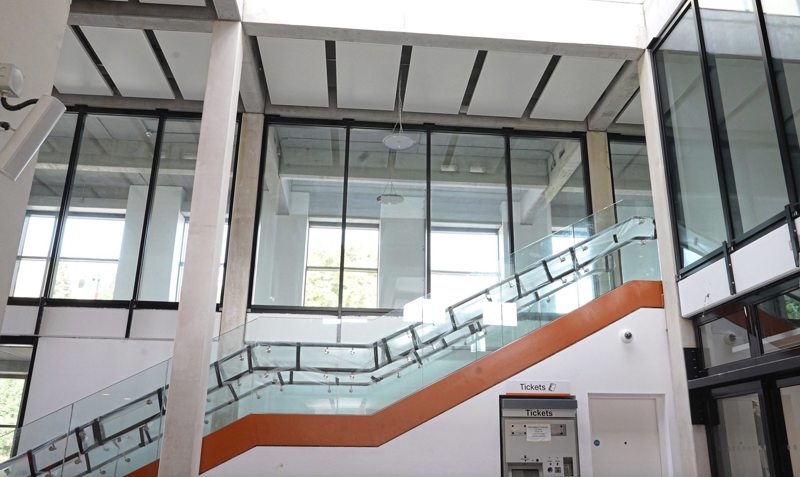
The view inside Birmingham University's well-lit new station foyer. Exposed concrete and glass are a nod to mid-century design.
It’s something that’s so far only been seen in some of the larger city centre stations - and the university wants to make full use of the new facility.
“The University of Birmingham wants to make the station feel like part of the campus, with some of their marketing branding going in there. It’s really nice that they want to make it a showcase and a front door to the university - something they can use to access more people,” says White.
University Station sits on the former Birmingham West Suburban Railway line and first came into being as part of an upgrade of the Cross-City line.
As well as being in the middle of a university and a hospital complex, it sits next to the Birmingham to Worcester canal and on the site of the ancient Metchley Roman Fort. For those building the new station, it was not the best location.
Phil Wood, Senior Project Manager at VolkerFitzpatrick, explains: “From a logistics perspective it’s heavily constrained, and that brings with it a whole lot of challenges. Then the building itself is really complex.
“This is not your average station - it’s an incredible building. The approach taken by the client is for a stand-out bit of architecture, which is on a railway.”
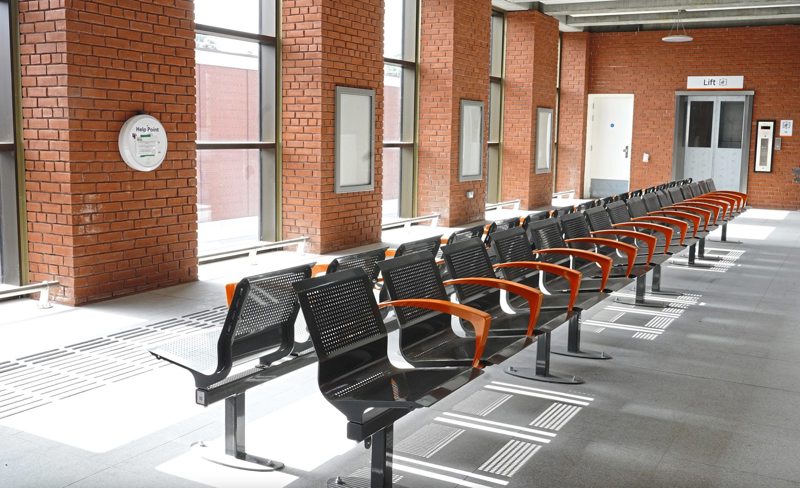
The waiting area seating is best described as functional. For passengers unable to use stairs, lift access is provided.
The new station is divided into two buildings - or Pavilions, as they’re referred to by those working on the project. Pavilion One sits on the Western side of the line, while Pavilion Two is sandwiched between the railway and the canal.
Several overnight weekend possessions were required to crane in new bridges and various other parts of the buildings which were manufactured offsite. Some have described the operation as one of the biggest ever ‘flatpack’ construction jobs.
“Some of the crane work needed to bring in things like the cladding required five lifts in sequence to get them into position,” says Wood.
Add the fact that the new station had to be built without any impact on the existing station, and you have one of the biggest rail logistical challenges on your hands.
“There’s been no time lost to the railway. We’ve had no issues with the Canal & River Trust from a stakeholder perspective as well. The canal was open to traffic throughout the build,” says Wood.
It's not just logistics that have proved challenging. The project team has had to work with multiple stakeholders - including several landowners, Network Rail, the hospital, Birmingham City Council, the university, and the Canal & River Trust.
Tony Walker, Project Sponsor at SLC Rail, says: “We have weekly meetings to go through the various arrangements. The land in some cases has been gifted, while other land remains with the various estates. We’ve had to do deeds of variation because some of the deeds go back a couple of centuries.”
It’s all resulted in a whole suite of legal documents between all the parties involved: “We intend to have them ready, and on the shelf and signed off, for when we enter service.”
This has all meant that the aspiration for an 18- to 24-month construction project back in the spring of 2021, has ended up taking an extra year. The original target was to open as much of the new facility as possible for the 2022 Commonwealth Games in Birmingham. With an accelerated build and re-prioritised platform and public realm works, the station was indeed ‘Games ready’ and spectator numbers were accommodated.
For those involved in the programme, the improvements meant a huge resequencing exercise, effectively turning the build into two separate projects.
Amanda White acknowledges that it was probably too ambitious to do both projects in parallel: “We had another replanning exercise following the Games to look at what we still had to do on the main station build. We’ve basically been flat out since then progressing with the project to get it operational.”
But even before then there was the not insignificant matter of a worldwide pandemic and the resulting hike in building inflation. At one point, one of the station’s crucial contractors that was supplying the bespoke cladding went bust.
Then there’s the archaeology. As mentioned, the new station sits on part of what used to be Metchley Roman Fort, dating back to c.48AD.
Those working on the project had to stay in close contact with Historic England to gain consent whenever they broke ground. As with other buildings in the area, Scheduled Ancient Monument Consent was required, plus approval from the Department for Digital, Culture, Media & Sport.
Alistair Keen, Senior Project Manager at SLC Rail, explains: “At the start of the scheme, we had a lot of discussions with Historic England to get approval for the project as the station is built on the Roman Fort. In fact, some of the station piles go through areas of historic interest. We needed to do everything we could to minimise the footprint and disturbance to the fort.”
Working around an ancient monument has meant having an archaeologist on site whenever there were excavations. Thankfully, the impact on the station build programme was minimal.
Despite missing the target to open for the Commonwealth Games, work on site hasn’t slowed down. VolkerFitzpatrick and its contractors have pulled out all the stops to get the job done.
“We’ve pretty much exhausted every opportunity with regards to productivity we can get out of the site,” says Wood.
“We’ve worked every weekend. We worked through Christmas. We worked 24 hours a day through January, February and into March. At one stage, in April and May, we were averaging 190 people on site, and at the peak we had 26 sub-contractors here in one day.”
That’s no mean feat considering the constraints on the site. Given the complexity of the project and the various issues along the way, there is little doubt that getting the station to where it is today is a major achievement - and one that both the West Midlands Combined Authority and those involved in the construction can be rightly proud.
With the station finally open, it provides an amazing arrival and departure point on a part of the network that many rail users rely on day in and day out.
Main image: West Midlands Railway 323206 calls at the new-look university station. PETER PILSNER

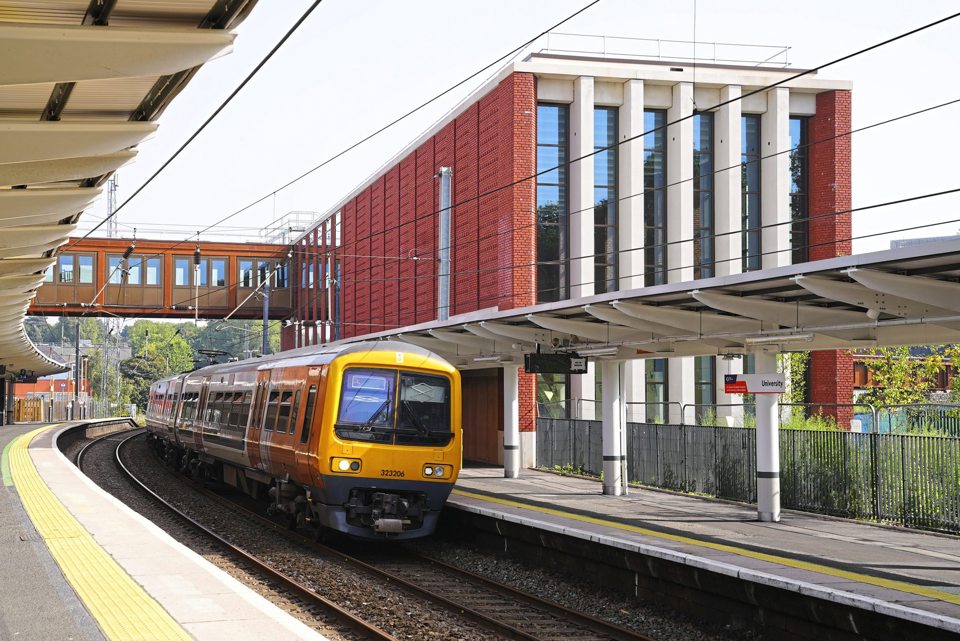

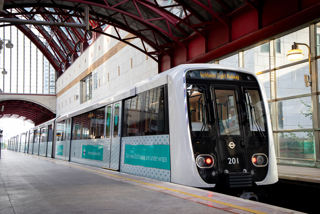
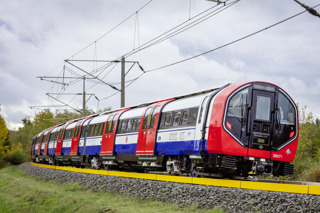
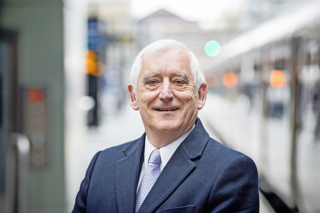
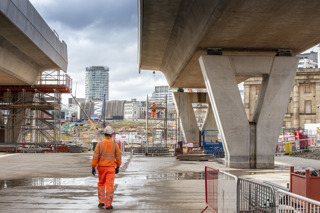
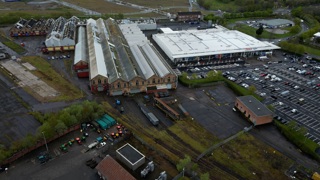











Login to comment
Comments
No comments have been made yet.